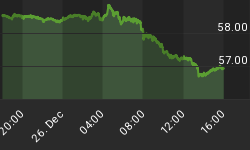The answer: Sell on rallies.
Is that what has been happening this year?
The chart below provides the answer. This chart shows the New York Stock Exchange Up-Volume plotted against the Dow Jones Industrials on a 60 minute chart going back to the beginning of the year.
The red dotted horizontal line marks the days where the Up Volume has been 30,000,000 or higher. I drew white vertical lines at these occurrences that show's what happened to the DJI in 5 instances this year.
As you can see on the chart below, the next day's Up Volume was lower, and the DJI stalled and then dropped as large investors used it as an opportunity to sell in the next few days.
Yesterday's Up Volume topped out at 48 million ... the second highest Up Volume day this year. Yesterday's rally was driven by a historically low number of stocks reaching New Highs. On Monday, the New Highs had dropped to 7. Since the year 2000, there were 12 times that the New Highs were 7 or less. Each represented an oversold condition where an intra-day upside bounce occurred within hours. (See yesterday's update for more details on this.)
So, yesterday was poised to have an oversold bounce ... only it also got a "shot in the arm" when the Fed and Central Bankers initiated a $200 billion injection in cash through loans in order to try and resolve the liquidity crisis.
That double influence sent stocks soaring yesterday.
Some things didn't change. Wall Street firms are still telling large clients to sell into rallies, we still have an unresolved bank freeze on lending actions, and the market was due to bounce on a very oversold condition yesterday.
Don't get too excited about yesterday's wonderful rally ... look at the overall conditions, selling on rallies behavior, and demand more proof from the market by exhibiting a follow-through before becoming a believer.
(Not a paid subscriber yet? Think about it, and get this kind of information every day about the what is behind the market's moves.)

















